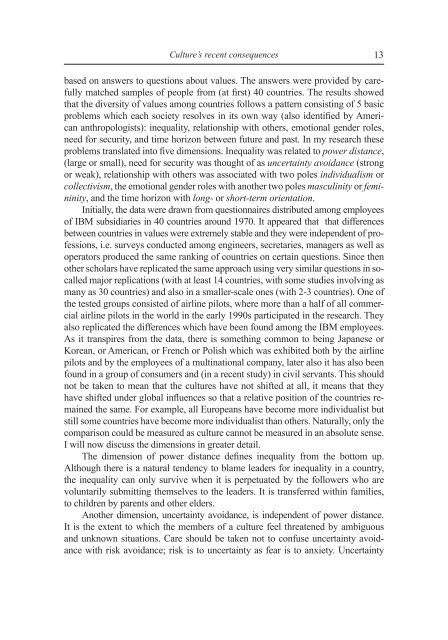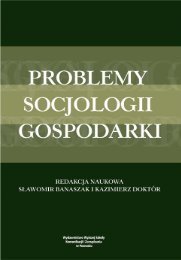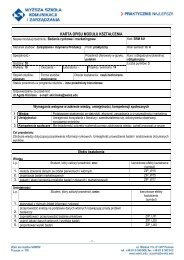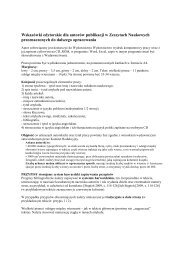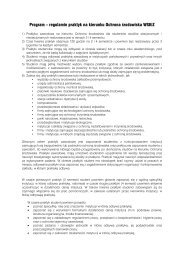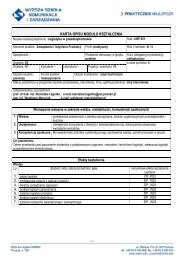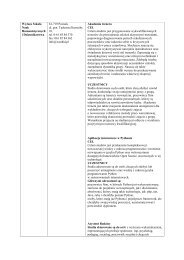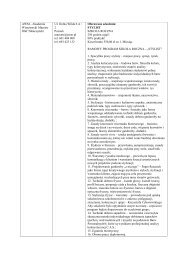- Page 2: Socjologicznei psychologiczneproble
- Page 6 and 7: Spis treściPrzedmowa..............
- Page 8 and 9: Słowo wstępneOddajemy do rąk Czy
- Page 16 and 17: Culture’s recent consequences 15c
- Page 18 and 19: Culture’s recent consequences 17o
- Page 20 and 21: Jan Sikora, Agnieszka Wartecka-Waż
- Page 22 and 23: Możliwości zastosowania modelu ku
- Page 24 and 25: Możliwości zastosowania modelu ku
- Page 26 and 27: Możliwości zastosowania modelu ku
- Page 28 and 29: Możliwości zastosowania modelu ku
- Page 30 and 31: Możliwości zastosowania modelu ku
- Page 32 and 33: Sylwester M. KaniaKulturowe wyznacz
- Page 34 and 35: Kulturowe wyznaczniki efektywności
- Page 36 and 37: Kulturowe wyznaczniki efektywności
- Page 38 and 39: Kulturowe wyznaczniki efektywności
- Page 40 and 41: Kulturowe wyznaczniki efektywności
- Page 42 and 43: Kulturowe wyznaczniki efektywności
- Page 44: Kulturowe wyznaczniki efektywności
- Page 47 and 48: 46Renata Krzykała-Schaeferzbieżno
- Page 49 and 50: 48Renata Krzykała-SchaeferMiędzyk
- Page 51 and 52: 50Renata Krzykała-Schaefercd. tabe
- Page 53 and 54: 52Renata Krzykała-SchaeferTabela 6
- Page 56 and 57: Międzykulturowe dylematy zarządza
- Page 58 and 59: Międzykulturowe dylematy zarządza
- Page 60 and 61:
Międzykulturowe dylematy zarządza
- Page 62 and 63:
Beata PawłowskaRytualizm zachowań
- Page 64 and 65:
Rytualizm zachowań organizacyjnych
- Page 66 and 67:
Rytualizm zachowań organizacyjnych
- Page 68 and 69:
Rytualizm zachowań organizacyjnych
- Page 70 and 71:
Rytualizm zachowań organizacyjnych
- Page 72 and 73:
Rytualizm zachowań organizacyjnych
- Page 74:
Rytualizm zachowań organizacyjnych
- Page 77 and 78:
76Jacek Korski, Sławomira Kamińsk
- Page 79 and 80:
78Jacek Korski, Sławomira Kamińsk
- Page 81 and 82:
80Jacek Korski, Sławomira Kamińsk
- Page 83 and 84:
82Jacek Korski, Sławomira Kamińsk
- Page 85 and 86:
84Jacek Korski, Sławomira Kamińsk
- Page 88 and 89:
Jacek KorskiBezpieczeństwo pracy w
- Page 90 and 91:
Bezpieczeństwo pracy w polskiej ko
- Page 92 and 93:
Bezpieczeństwo pracy w polskiej ko
- Page 94 and 95:
Bezpieczeństwo pracy w polskiej ko
- Page 96 and 97:
Bezpieczeństwo pracy w polskiej ko
- Page 98 and 99:
Rüdiger WinkThe Re-organisation of
- Page 100 and 101:
The Re-organisation of Value Chain
- Page 102 and 103:
The Re-organisation of Value Chain
- Page 104 and 105:
The Re-organisation of Value Chain
- Page 106 and 107:
The Re-organisation of Value Chain
- Page 108 and 109:
The Re-organisation of Value Chain
- Page 110 and 111:
The Re-organisation of Value Chain
- Page 112 and 113:
The Re-organisation of Value Chain
- Page 114 and 115:
The Re-organisation of Value Chain
- Page 116 and 117:
The Re-organisation of Value Chain
- Page 118:
Część IIKierownicy jako główni
- Page 121 and 122:
120Kazimierz Doktórpodmiot panowan
- Page 123 and 124:
122Kazimierz DoktórDynamika status
- Page 125 and 126:
124Kazimierz Doktórwykształcenia
- Page 127 and 128:
126Kazimierz DoktórModel psycholog
- Page 130 and 131:
Sławomir BanaszakDylematy moralne
- Page 132 and 133:
Dylematy moralne współczesnych me
- Page 134 and 135:
Dylematy moralne współczesnych me
- Page 136 and 137:
Dylematy moralne współczesnych me
- Page 138 and 139:
Dylematy moralne współczesnych me
- Page 140:
Dylematy moralne współczesnych me
- Page 143 and 144:
142Agnieszka Kozakcodziennych wybor
- Page 145 and 146:
144Agnieszka KozakFirma AWykres 1.
- Page 147 and 148:
146Agnieszka Kozakpoziom takich zac
- Page 149 and 150:
148Agnieszka KozakWykres 4. Poziom
- Page 151 and 152:
150Agnieszka Kozaknimi ludzie byli
- Page 153 and 154:
152Ilona Świątek-Barylska, Bożen
- Page 155 and 156:
154Ilona Świątek-Barylska, Bożen
- Page 157 and 158:
156Ilona Świątek-Barylska, Bożen
- Page 159 and 160:
158Ilona Świątek-Barylska, Bożen
- Page 161 and 162:
160Ilona Świątek-Barylska, Bożen
- Page 163 and 164:
162Przemysław Wechtaprodukcji popr
- Page 165 and 166:
164Przemysław Wechtawytwarzana prz
- Page 167 and 168:
166Przemysław WechtaPojęcie przed
- Page 170 and 171:
Mariola ŁagunaPozytywne przekonani
- Page 172 and 173:
Pozytywne przekonania na temat Ja u
- Page 174 and 175:
Pozytywne przekonania na temat Ja u
- Page 176 and 177:
Pozytywne przekonania na temat Ja u
- Page 178 and 179:
Pozytywne przekonania na temat Ja u
- Page 180 and 181:
Pozytywne przekonania na temat Ja u
- Page 182:
Pozytywne przekonania na temat Ja u
- Page 185 and 186:
184Jagoda Jeziorosiągnięciach: sa
- Page 187 and 188:
186Jagoda Jeziorw gospodarce, choci
- Page 189 and 190:
188Jagoda Jeziorobowiązków w śro
- Page 191 and 192:
190Jagoda Jeziorcd. tabeli 1.Łatwo
- Page 193 and 194:
192Jagoda Jeziorw fakcie, że 84,8%
- Page 195 and 196:
194Jagoda Jeziorpozytywnego nastawi
- Page 197 and 198:
196Jagoda Jeziorfakt znaczącego ud
- Page 199 and 200:
198Jagoda JeziorRopęga J., 2002, B
- Page 202 and 203:
Andrzej SuwalskiProblem partycypacj
- Page 204 and 205:
Problem partycypacji pracowniczej w
- Page 206 and 207:
Problem partycypacji pracowniczej w
- Page 208 and 209:
Problem partycypacji pracowniczej w
- Page 210 and 211:
Janina Stankiewicz, Marta Moczulska
- Page 212 and 213:
Formy partycypacji pracowników a m
- Page 214 and 215:
Formy partycypacji pracowników a m
- Page 216 and 217:
Formy partycypacji pracowników a m
- Page 218 and 219:
Formy partycypacji pracowników a m
- Page 220 and 221:
Formy partycypacji pracowników a m
- Page 222:
Część IVProblemy polityki person
- Page 225 and 226:
224Grażyna Bartkowiaksprawiająca,
- Page 227 and 228:
226Grażyna BartkowiakTabela 2. Inf
- Page 229 and 230:
228Grażyna Bartkowiakpracowników
- Page 231 and 232:
300Grażyna Bartkowiaknie odczuwaj
- Page 233 and 234:
232Elżbieta Kowalczykwiedzę, swoj
- Page 235 and 236:
234Elżbieta Kowalczykrachunek wzra
- Page 237 and 238:
236Elżbieta Kowalczykponadto malej
- Page 239 and 240:
238Elżbieta Kowalczykświadomym od
- Page 241 and 242:
240Elżbieta KowalczykWśród grupy
- Page 243 and 244:
242Elżbieta KowalczykWynegocjowany
- Page 246:
Część VSpołeczna odpowiedzialno
- Page 249 and 250:
248Henryk Januszekpropaguje własne
- Page 251 and 252:
250Henryk Januszekw celu dojścia d
- Page 253 and 254:
252Henryk JanuszekGlobalne Zasady S
- Page 255 and 256:
254Henryk JanuszekPreambuła dokume
- Page 257 and 258:
256Henryk Januszekrozwijającej si
- Page 259 and 260:
258Henryk Januszek(Green Paper: 22)
- Page 261 and 262:
260Henryk Januszekangażuje się w
- Page 264 and 265:
Małgorzata Suchacka, Marek S. Szcz
- Page 266 and 267:
Między filantropią a funkcjonaln
- Page 268 and 269:
Między filantropią a funkcjonaln
- Page 270 and 271:
Między filantropią a funkcjonaln
- Page 272:
Między filantropią a funkcjonaln
- Page 275 and 276:
274Małgorzata Adamska-Chudzińskap
- Page 277 and 278:
276Małgorzata Adamska-Chudzińskap
- Page 279 and 280:
278Małgorzata Adamska-Chudzińskaw
- Page 281 and 282:
280Barbara FryzełAktywiści (NGOs,
- Page 283 and 284:
282Barbara Fryzełw zależności od
- Page 285 and 286:
284Barbara FryzełProponowana przez
- Page 287 and 288:
286Barbara FryzełPodejmując dialo
- Page 289 and 290:
288Barbara Fryzeło symbolikę meta
- Page 291 and 292:
290Barbara FryzełMcWilliams A., Si
- Page 293 and 294:
292Sebastian SkolikDoprowadziło to
- Page 295 and 296:
294Sebastian Skolikrytuały, jak np
- Page 297 and 298:
296Sebastian Skolikjednostkami wytw
- Page 299 and 300:
298Sebastian Skolikartykułu trwaj
- Page 301 and 302:
300Sebastian Skoliksię zapytania o
- Page 303 and 304:
302Sebastian SkolikTego typu konfli
- Page 305 and 306:
304Sebastian Skolikużytkowników j
- Page 308 and 309:
Arleta Olbrot-BrzezińskaWolontaria
- Page 310 and 311:
Wolontariat pracowniczy - zaangażo
- Page 312 and 313:
Wolontariat pracowniczy - zaangażo
- Page 314 and 315:
Wolontariat pracowniczy - zaangażo
- Page 316 and 317:
Wolontariat pracowniczy - zaangażo
- Page 318 and 319:
Wolontariat pracowniczy - zaangażo
- Page 320 and 321:
Wolontariat pracowniczy - zaangażo
- Page 322 and 323:
Justyna Kliombka-JarzynaSpółdziel
- Page 324 and 325:
Spółdzielnia socjalna jako forma
- Page 326 and 327:
Spółdzielnia socjalna jako forma
- Page 328 and 329:
Spółdzielnia socjalna jako forma
- Page 330 and 331:
Spółdzielnia socjalna jako forma
- Page 332:
Część VIRynek pracy a organizacy
- Page 335 and 336:
334Jerzy Olszewskiw sprawie stosowa
- Page 337 and 338:
336Jerzy OlszewskiAnaliza wskaźnik
- Page 339 and 340:
338Jerzy Olszewskiw tym kierunku pr
- Page 341 and 342:
340Jerzy Olszewskido upośledzenia
- Page 343 and 344:
342Jerzy Olszewski0,80,70,60,50,40,
- Page 345 and 346:
344Jerzy OlszewskiJednak gdy zestaw
- Page 347 and 348:
346Jerzy OlszewskiWiek kobiet aktyw
- Page 349 and 350:
348Jerzy Olszewskiwymiarze czasu pr
- Page 351 and 352:
350Jerzy OlszewskiLiteraturaA-Z pop
- Page 354 and 355:
Zbigniew GalorLumpenorganizacja? -
- Page 356 and 357:
Lumpenorganizacja? - Organizacja i
- Page 358 and 359:
Lumpenorganizacja? - Organizacja i
- Page 360 and 361:
Lumpenorganizacja? - Organizacja i
- Page 362 and 363:
Lumpenorganizacja? - Organizacja i
- Page 364:
Lumpenorganizacja? - Organizacja i
- Page 367 and 368:
366Joanna Hałaj+Ocena zadania któ
- Page 369 and 370:
368Joanna Hałajsię w sytuacji wym
- Page 371 and 372:
370Joanna Hałaj4,003,903,803,703,6
- Page 373 and 374:
372Joanna Hałajrelacjami interpers
- Page 375 and 376:
374Joanna Hałaj4,0003,5003,0002,50
- Page 378 and 379:
Katarzyna DurniatMobbing w Polsce n
- Page 380 and 381:
Mobbing w Polsce na tle klimatu org
- Page 382 and 383:
Mobbing w Polsce na tle klimatu org
- Page 384 and 385:
Mobbing w Polsce na tle klimatu org
- Page 386 and 387:
Mobbing w Polsce na tle klimatu org
- Page 388 and 389:
Mobbing w Polsce na tle klimatu org
- Page 390 and 391:
Mobbing w Polsce na tle klimatu org
- Page 392 and 393:
Mobbing w Polsce na tle klimatu org
- Page 394 and 395:
Noty o AutorachDr Małgorzata Adams


